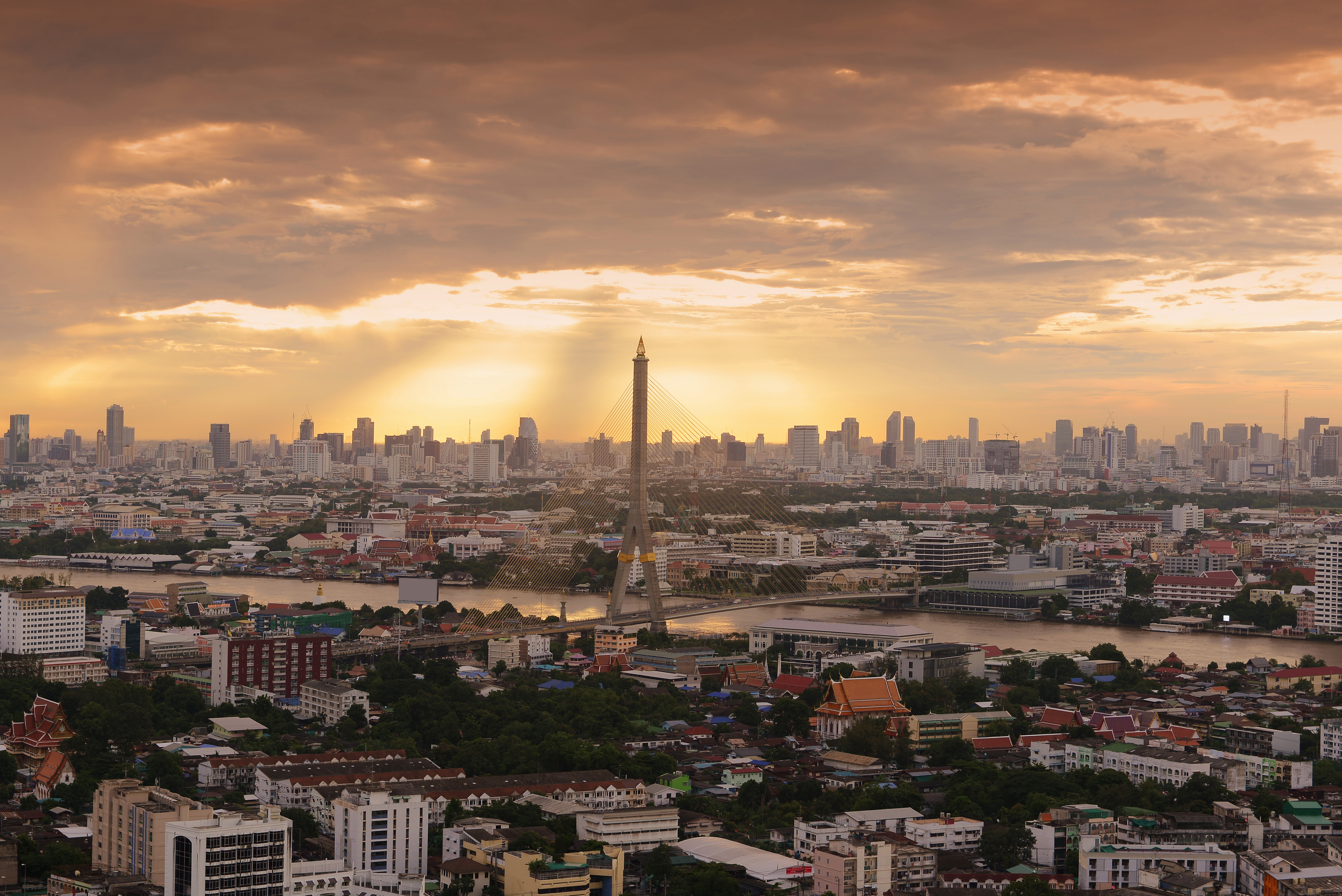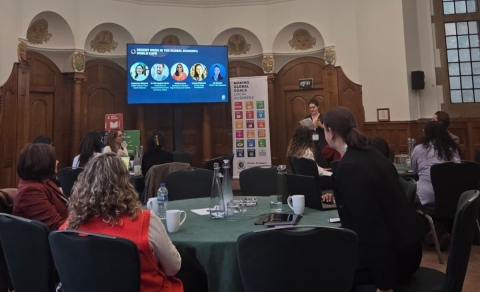5 takeaways from the INFF Asia-Pacific Knowledge Exchange
23 JUNE, 2023

Tampatra for Envato
Event recap:
Watch the event recording: Day 1 | Day 2 and explore event presentations. Event page is available here.
The INFF Asia Pacific Knowledge Exchange kicked off SDG Finance Week in Bangkok last week. The two-day event brought together more than 130 participants from governments, investors, banks, international financial institutions (IFIs), development finance institutions (DFIs), academia, bond issuers and civil society from 20 countries across Asia Pacific.
Countries are using INFFs to promote changes in the national financing architecture to better align all financing flows towards the SDGs and Nationally Determined Contributions (NDCs). Countries shared their experiences in the panel discussions and hosted booths at the SDG Finance Marketplace. The event highlighted the depth and breadth of innovation in SDG financing across this dynamic region in a challenging financing environment.
“INFF is becoming a game changer in shaping a new SDG-aligned financing architecture in 16 countries in Asia-Pacific, forging new public and private partnerships at global and national levels and unlocking financing flows for the SDGs,” said Christophe Bahuet, Deputy Regional Director for Asia Pacific, Director, Bangkok Regional Hub, UNDP, in the opening session.
The event was hosted by the Integrated National Financing Facility (INFF Facility), United Nations Development Programme (UNDP), United Nations Department of Economic and Social Affairs (UNDESA), United Nations Economic and Social Commission for Asia and the Pacific (UNESCAP) and European Union.
Here are five takeaways from the event:
1. Countries across the region are reshaping the financing architecture at the national level through their integrated national financing frameworks
“We are using our INFF to turn three major challenges – fossil fuel dependency, the impacts of climate change and lack of investment in climate – into opportunities to align all financing behind investment in a more resilient development path.” – Ahmed Saruvash Adam, Chief Financial Budget Executive, Ministry of Finance of Maldives.
Maldives was the first small island developing state to launch a financing strategy - its gender-responsive climate financing strategy, in March this year. The Ministry of Finance is establishing a climate finance hub to implement the 16 objectives of the financing strategy which will mobilize and align financing in response to the estimated $800 million - $1.5 billion cost.
Mongolia endorsed its INFF strategy last year, the first to do so globally. Tuguldur Galbadrakh from the Ministry of Economy and Development noted that $44.2 billion is needed for financing development. Through the INFF, Mongolia is advancing public and private measures to mobilize and align capital with its five-year development plan. For public sector finance, those measures include SDG-aligned tax policies to raise revenue, SDG audits, result-based budgeting and result-based planning. Private capital, measures include SDG finance taxonomy as well as new legislation on public-private partnerships (PPPs) and investment.
Indonesia launched its INFF report last year during its G20 Presidency. Setyo Budiantoro from Bappenas, the Ministry of National Planning, highlighted the challenge of navigating diverse financing flows and instruments against the backdrop of a challenging global crisis. Indonesia is using its INFF to advance a strategy for diversifying sources of financing for development, aligning capital towards national SDG priorities.
“INFFs have to be country-led and country-owned. They adapt to the national contexts, so no INFF look the same to any other,” noted Natalia Aristizabal Mora, Inter-Regional Adviser, Financing for Sustainable Development, UN DESA. This point was amply illustrated in the country presentations throughout the workshop, and most especially in the session on SIDS, where additional guidance on the implementation of INFFs in these states was also discussed.
2. From taxonomies and disclosure to monitoring and auditing, countries are finding innovative ways to promote alignment of private sector investment and business models that work for the SDGs and the Paris Agreement
“There are good reasons for countries to tailor their taxonomies to their national circumstances, while interoperability should also be encouraged. Sustainable finance is essential to ensure transition to a sustainable future and we don’t want to limit that to just domestic capital funding domestic projects.” – Ronald Young, Head of Sustainable Finance for Asia, Societe Generale.
Ministries, regulators, businesses, banks and investors explained how countries across the region are strengthening the enabling environment and innovating to bring sustainable investments and business models to scale.
The Malaysian Government hopes for its private sector to be a leader in international sustainability standards and is designing initiatives around ESG disclosures and reporting.
In fossil-fuel dependent, Thailand, the Securities and Exchange Commission, Central Bank and the Stock Exchange are all promoting sustainable finance in line with the SDGs and the Paris Agreement. The Thai Bankers Association published the Future Landscape Banking Sector of Thailand to help the private sector understand how the banking sector can help its clients transition to net zero.
India has a long history of targeted social finance, with banks required to allocate 40% of their advances to agriculture, SMEs, renewables, affordable housing and other priority sectors. The social enterprise sector is growing rapidly, at 20-25% a year, aided by the establishment of a monitoring and accountability ecosystem with clear definitions and standards. The aim is to ease access to commercial and philanthropic capital, alongside the creation of a social stock exchange.
Shanaz Patel from the EU Delegation to Indonesia and ASEAN highlighted how, "the SDGs require a significant increase in financial resources and the private sector plays a crucial role in bridging the funding gap; at the same time, to meet the SDGs we need to ensure that private investments respect the highest social, environmental and quality standards. This is also at the core of the EU's Global Gateway strategy."
3. Blended finance, sustainable, green, blue and orange bonds are being deployed to unlock private investment to accelerate sustainable development
"INFF can help countries like Indonesia to strengthen planning processes, overcome existing obstacles, and identify new instruments for financing… within the INFF framework the issuance of thematic bonds such as green sukuk, SDG bonds, and SDG blue bonds is recognised by all stakeholders as financing instruments toward the lower carbon economy and sustainable development path.” – Deni Ridwan, Director of Government Debt Securities, Ministry of Finance of Indonesia.
Indonesia built a system for tracking public investment in climate mitigation and adaptation that catalyzed its journey with thematic bond issuances, starting with a green sukuk and most recently branching out into an inaugural $150m blue bond issuance earlier this month.
AnnaMaria Oltorp, Head of the Regional Development Cooperation Section of the Swedish Embassy in Bangkok noted that, "SDG sovereign bonds represent an effective way to catalyze large financial flows for public finance such as for countries' investment needs in health, education, biodiversity and climate alignment.” We also heard about the growth in innovative orange bonds. These vehicles for gender-lens investing more than doubled last year even while issuance of other thematic bonds fell by 19% within difficult market conditions. Natasha Garcha, Senior Director at the Impact Investment Exchange noted that “this isn’t just a nice thing to do – it helps stabilise returns and reduce risk … while contributing to multiple SDGs.”
These developments are taking place despite the region’s rising debt levels - 11 of the countries most vulnerable to debt distress worldwide are in Asia-Pacific. In 2021, public debt in the region reached its highest level in 18 years due to high fiscal deficit and currency devaluation, noted Vatcharin Sirimaneetham, ESCAP. He also highlighted an augmented debt sustainability analysis approach that can provide a more holistic and long-term picture of future government debt trajectories. Pakistan, shared its experience with high debt levels and increasing financing needs, with an estimated $16 billion required due to the floods in 2022. Debt sustainability strategic guidelines emphasise transparency, fiscal sustainability, reasonable cost of borrowing, strengthened debt management and the development of domestic debt markets.
Blended finance is becoming more crucial to crowd private finance, including in agriculture, and adaptation which are typically hard for the private sector to invest in, particularly in our current times of increasing fiscal distress and volatility, explained Joan Larrea, CEO, Convergence Blended Finance. In Least Developed Countries (LDCs) and SIDS countries, blended finance can potentially diversify financial sources if done right.
Shreejesh Ghimire, Chief Investment Officer of NMB Bank, Nepal highlighted that Nepal was successful in incentivizing and de-risking commercial banks’ debt portfolio in renewable energy sector. The bank, which has a target for 15% of its portfolio to be in clean energy by 2030, is piloting a new impact-based blended debt instrument and has been able to achieve a 2.5 times leverage ratio. Building on this experience, the Ministry of Finance of Nepal recently announced the development of an INFF, including promoting blended finance and solutions in digital finance and other areas. “INFF offers the enabler to pool all sources of finance together and provide the window of opportunity to leverage private finance towards the SDGs,” commented Muktiram Acharya, from the Ministry of Finance of Nepal.
Andrew Koroi from the Ministry of Finance in Fiji said that the country is facilitating the development of MSMEs and pipelines in blue sectors such as water, waste management, sustainable tourism and fishery sectors. This is funded through grants from Global Fund for Coral Reef (GFCR) and UN Joint SDG Fund with loans from the private sector (e.g., Blue Finance Marine Protected Areas Facility). Fiji is planning its first ever sovereign blue bond which was borne out of a wider a sustainable bond framework.
Still, challenges remain. Investors’ perception of cost and risk of investment in development are still high. Investors also find it hard to identify and assure the impact outcomes of their investees. Development partners and development financing institutions (DFIs) have difficulty in identifying investable sectors and their scalability. Participants discussed a range of potential solutions, from streamlining and standardized blended models, building a more stable policy environment that enables longer-term investment and standardizing approaches for capturing real impacts, particularly for MSMEs with limited capacity.
4. The importance of aligning budgets to the SDGs, and protecting expenditure in key SDG sectors, has never been greater
“The SDGs indicators are the performance benchmarks for the Philippines to ensure the alignment of national planning, programming, budgeting and monitoring and accountability.” – Hazel Iris Baliatan, Director, National Economic Development Authority (NEDA), Philippines.
Public finance remains the main source of finance for countries to achieve the SDGs. The importance of aligning budgets to sustainable development priorities has never been greater. Nohman Ishtiaq, Public Finance Lead from UNDP’s Sustainable Finance Hub, highlighted how countries in the region spend 20-30% of their GDP through public budgets annually. The Philippines has incorporated the SDGs into the national results matrices with line ministries using these indicators as the basis for formulating public investment programmes and budget submissions. In Bangladesh climate factors have been integrated into the budget classification system, facilitating the tracking of public spending on mitigation and adaptation, enabling greater transparency and analysis of efficiency.
UNICEF’s Andrea Rossi, an advisor on social policy and economic analysis, highlighted that some governments in the region are cutting social expenditure that had been ramped up in the aftermath of COVID-19. The impact and loss of not investing in health and education will be dramatic because inclusion is the key to public finance investment to reduce inequality.
At the same time, The IMF emphasised the need to understand the cost of development goals, estimating that additional spending of 5-10% of GDP is needed in emerging markets and least developed countries in the region to achieve goals in five macro-critical sectors: health, education, water and sanitation, electricity and roads.
5. Countries are finding ways to mobilize revenues and align tax policies with sustainable development priorities despite the challenging fiscal outlook
“The INFF methodology allows a very organic way of thinking about resource mobilization … to consider what is the amount we want to tax, what do we want and not want to tax in relation to the SDGs, and how to do it effectively, as well as issues of tax compliance.” – Alberto Isgut, Economic Affairs Officer, Macroeconomic Policy and Financing for Development Department, UN-ESCAP.
UNDP’s regional tax specialist Sudarshan Kasturirangan highlighted how countries across the region have the potential to increase revenues by as much as 3.6% of GDP on average. There are opportunities for gains in three areas: corporate minimum taxes; coherence between tax, trade and investment policies; and fiscal citizenship including strengthening tax institutions and improved transparency.
Timor-Leste has one of the highest rates of smoking in the world with an estimated 35% of the population aged 15 years and above using tobacco. The Government of Timor-Leste introduced a new tax package on tobacco, sugar and sweetened beverages in 2022. This has raised additional revenue with a small reduction in smoking rates already observed, an important contribution to SDG3 and reduced strain on future health services.
In Mongolia the mining sector, which is dominated by multinationals, accounts for a major part of the economy and is a key source of tax revenue. The Mongolian tax authority has established a transfer pricing unit with the support of Tax Inspectors Without Borders (TIWB) and conducted transfer pricing audits in the mining sector, resulting in an additional $228 million in compensatory taxes.
Sri Lanka, which has seen tax revenues fall sharply from 21% of GDP following the crisis, is implementing a package of reforms including eliminating tax expenditures, broadening the tax base and digitalising the tax system.
Across the region, countries are innovating in SDG financing and have a lot to share and learn from one another, even in the face of strong global economic headwinds.
"What this two-day event reinforced is the importance of a whole of society approach in making the 2030 SDG agenda possible in all countries; for Malaysia … there is a change management that needs to be applied across the government machinery and also to leverage the contribution from the private sector, to move the country as a team." – Nirwan Noh, Deputy Undersecretary of the Ministry of Finance of Malaysia.
Stay tuned for further dialogue and exchange among this community of INFF practitioners in the future.
Further resources:
- The State of INFFs in 2023
- INFF Facility: INFF deep dive technical guidance documents and INFF e-learning course
- UNESCAP: Asia and the Pacific SDG progress report 2023
- UNDP: Avoiding too little too late on international debt relief
- IMF: Regional economic outlook for Asia and the Pacific
- IMF: SDG FiT (SDG Financing Tool)











